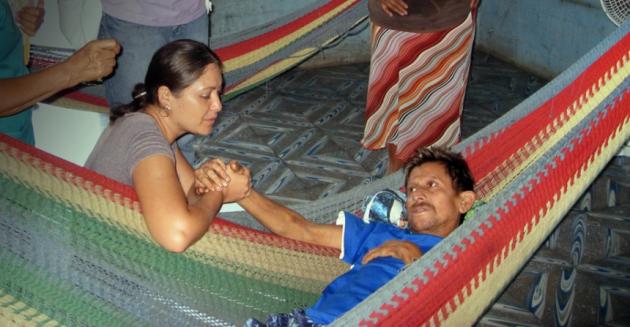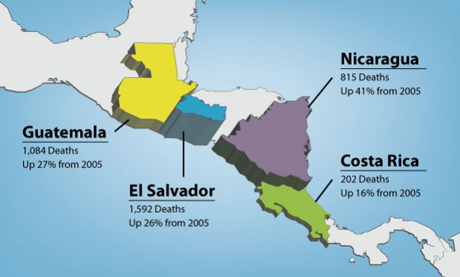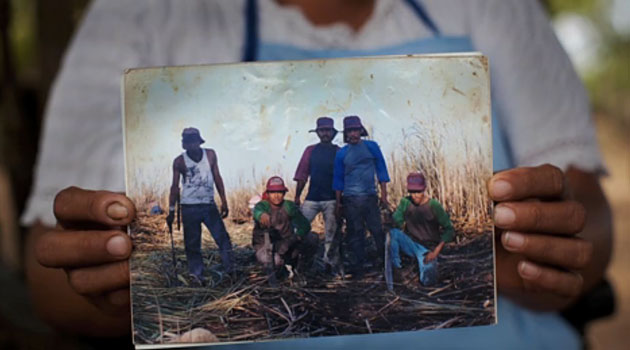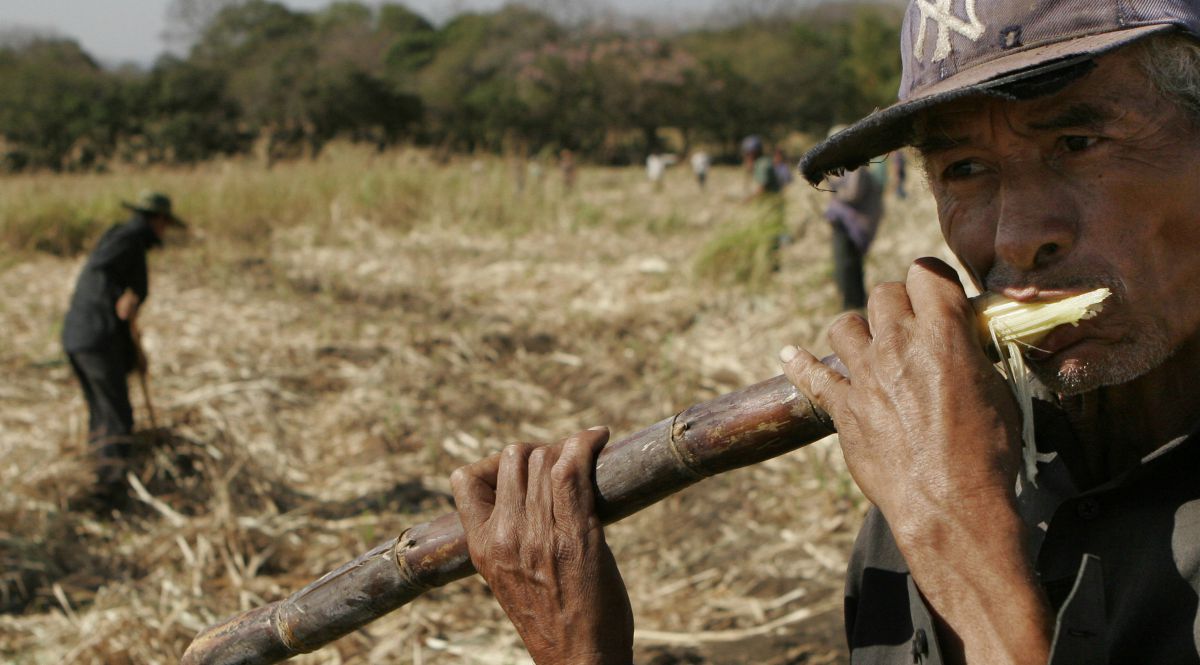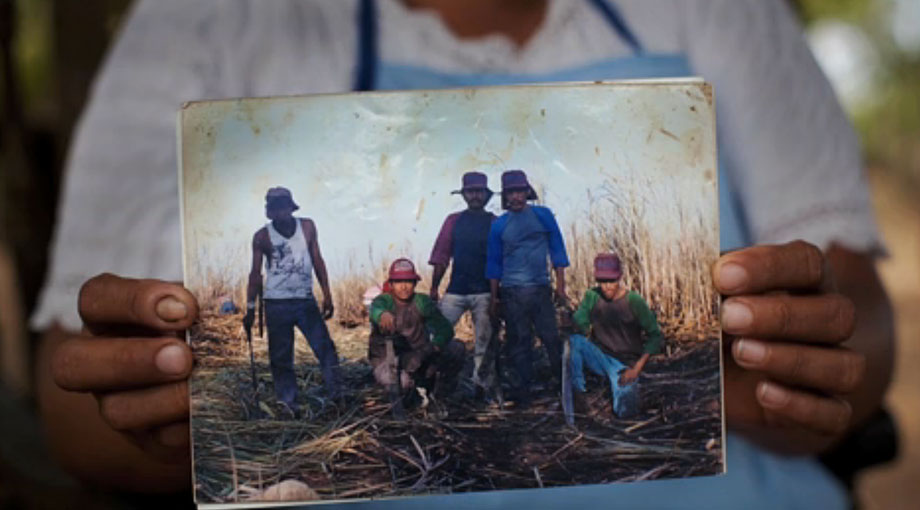Maudiel Martinez is 19 years old and has a shy smile, a tangle of curly black hair and a lean, muscular build shaped by years of work in the sugarcane fields. For most of his adolescence, he was healthy and strong and spent his days chopping tall stalks of cane with his machete.
Now Martinez is suffering from a deadly disease that is devastating his community along with scores of others in Central America, where it has decimated the ranks of sugarcane workers. The same illness killed his father and his grandfather and affects all three of his older brothers.
“This disease eats our kidneys from inside us,” Martinez said. “We don’t want to die, and we feel grief because we already know that we’re hopeless.”
Martinez’ illness stands at the heart of a lethal mystery — and legacy of neglect by industry and governments, including the United States, which have resisted pleas for aggressive action to spotlight the malady and find a remedy. Wealthier nations are more focused on spurring biofuels production in the region’s sugarcane industry and keeping up the heavy flow of sugar to U.S. consumers and food manufacturers than the plight of those who harvest it.
Little noticed by the rest of the world, chronic kidney disease (CKD) is cutting a swath through one of the world’s poorest populations, along a stretch of Central America’s Pacific Coast that spans six countries and nearly 700 miles. Its victims are manual laborers, mostly sugarcane workers.
Each year from 2005 to 2009, kidney failure killed more than 2,800 men in Central America, according to the International Consortium of Investigative Journalists‘ analysis of the latest World Health Organization data. In El Salvador and Nicaragua alone over the last two decades, the number of men dying from kidney disease has risen fivefold. Now more men are dying from the ailment than from HIV/AIDS, diabetes and leukemia combined.
“In the 21st Century, nobody should die of kidney disease,” said Ramon Trabanino, a physician from El Salvador who has studied the epidemic for a decade.
The surge of kidney disease is overwhelming hospitals, depleting health budgets, and leaving a trail of widows and children in rural communities. In El Salvador, CKD is the second leading cause of death for men. In the province of Guanacaste, Costa Rica, the regional hospital had to start a home dialysis program because it was overwhelmed with so many CKD victims that it began running out of beds to treat patients with other ailments.
So many men have died in some parts of rural Nicaragua that Maudiel Martinez’s community, called The Island, now is known as the Island of the Widows — La Isla de las Viudas.
At first glance, the lush community bounded by vast sugarcane fields looks like many places in Latin America: children ride bicycles over dirt roads and play alongside dogs, pigs and chickens. But now there are few men in the front yards. Indoors, framed photographs of dead husbands, fathers and brothers adorn tables and countertops. No older men converge in small groups, trading gossip and news, as one often sees in communities farther inland from the Pacific coast.
Here, women struggle to make at least a little money doing odd jobs. Some are now in the sugar-cane fields they believe claimed their husbands.
“My children have suffered a lot,” said Paula Chevez Ruiz, a widow from La Isla whose husband Virgilio died in 2009, leaving her to support four children on her own. When she can find customers, she sells fruit and enchiladas. “It is sad to want to give to your children, but not to have anything. Sometimes not even enough to buy a bag of salt.”
Deadly enigma and a handful of researchers
In the U.S. leading causes of chronic kidney disease are diabetes and hypertension. But the ailment — leading to a progressive decline in kidney function — is typically a manageable condition that can be effectively controlled with treatment. Doctors understand its causes and cures.
In Central America, the disease’s origins are more of an enigma, and more frequently lethal. Afflicted laborers in the sugar cane fields near the Pacific generally have neither diabetes nor hypertension.
Some scientists suspect that exposure to an unknown toxin, potentially on the job, may trigger onset of the disease. Researchers agree that dehydration and heat stress from strenuous labor are likely contributing factors — and they may even be causing the illness. Laborers, typically paid not by the hour or day but based on the amount they harvest, often work to the point of severe dehydration or collapse, potentially harming their kidneys with each shift.
CKD usually attacks small blood vessels in the kidney called the glomeruli; the Central American epidemic attacks the kidney’s tubules. CKD generally affects older people with equal distribution between sexes; this epidemic overwhelmingly affects working-age men, mostly sugarcane workers but also miners and other agricultural laborers.
A growing community of researchers is calling for recognition of a new illness not yet included in medical manuals: “Mesoamerican nephropathy,” “endemic agricultural nephropathy” or “sugarcane nephropathy.” The director of El Salvador’s national CKD program has written of a “Mesoamerican Regional Nephropathy” that would one day be internationally recognized.
“It is important that the chronic kidney disease afflicting thousands of rural workers in Central America be recognized as what it is: a major epidemic with a tremendous population impact,” said Victor Penchaszadeh, a clinical epidemiologist at Columbia University and frequent consultant to the Pan American Health Organization on chronic diseases in Latin America.
Dr. Ramon Vanegas, a nephrologist who assesses applications by workers to Nicaragua’s Institute of Social Security for occupational illness pensions, said cases which he defines as occupational CKD follow a pattern of tubular kidney damage combined with a history of heat stroke.
“Usually they have been working, and they had muscle spasms, they’ve gotten fever, they have collapsed,” Vanegas said of the patients whose applications he approves. “Then they return to work, they face the same exposures, and the cycle repeats. Then, two or three years later, the patient has [CKD].”
While physicians mull labels and diagnoses, the mystery persists: Why does this particular form of CKD attack men in a particular way — and in this specific region?
Some studies suggest risk factors, from pesticide exposure to alcohol abuse to frequent use of anti-inflammatory drugs, may play important roles in CKD’s onset. Others show that miners, stevedores and field workers in affected regions also have high CKD rates; a study in Nicaragua found a mining town to have one of the highest prevalence rates in the country.
“The evidence points us most strongly to a hypothesis that perhaps heat stress — hard work in a hot climate without sufficient replacement of fluids — might be a cause of this disease,” said Daniel Brooks, lead researcher of a scientific team from Boston University that is among a handful of groups conducting early studies.
During days the team observed sugar cane workers, the mean temperature in the fields was 96 degrees. Their report noted that the U.S. Occupational Safety and Health Administration, which oversees safety at U.S. workplaces, calls for 45 minutes of rest for every 15 minutes of work at that heat stress level.
The team’s preliminary research bolsters the heat stress hypothesis; blood and urine samples taken from different types of sugarcane workers during the course of a harvest season show more evidence of kidney damage among those who did strenuous labor outside. Earlier, the team identified a number of work practices and chemicals at the company that could potentially damage the kidneys. Brooks said more research is needed before conclusions can be drawn.
Internal studies by Nicaragua Sugar, owners of one of Central America’s largest sugar plantations, provided by the company to ICIJ, show that the company has long had evidence of an epidemic tied to heat stress and dehydration. In 2001, company doctor Felix Zelaya conducted an internal study on the causes of CKD among its workers. “Strenuous labor with exposure to high environmental temperatures without an adequate hydration program predisposes workers to heat stress syndrome [heat stroke], which is an important factor in the development of CKD,” Zelaya concluded.
Nicaragua Sugar and other companies say they have acted voluntarily to protect workers by improving hydration, reducing work hours, and strengthening oversight of labor contractors.
Even so, Nicaragua Sugar disputes the existence of a unique kidney ailment affecting its workers. “We’re convinced that we have nothing to do with kidney disease,” said spokesman Ariel Granera. “Our productive practices do not generate and are not causal factors for CKD.”
Signs of trouble
In 2000, Salvadoran physician Trabanino noticed large numbers of young and middle-aged men coming into his hospital in El Salvador, all with advanced cases of chronic kidney disease. “For some reason, to the rest of the world this seemed normal,” he recalled. “To me it seemed strange and curious.”

In 2002, Trabanino published one of the first studies of the disease, a profile of 205 new patients admitted to his hospital with end-stage renal disease. Two-thirds of these cases lacked the usual risk factors for chronic kidney disease — and had some common features.
“They were almost all men who lived in the low-lying zones of the country, close to the coast, near a major river,” Trabanino wrote in the Pan American Journal of Public Health. A large group of these patients also described “frequent occupational contact without adequate protection with insecticides and pesticides.”
Another study of kidney patients from northern Costa Rica — again from a sweltering, low-lying region near the Pacific Coast — described a similar pattern.
“All are young men, between the ages of 20 and 40 years,” wrote Dr. Manuel Cerdas of Costa Rica in the journal Kidney International. “The most interesting feature of these patients is epidemiologic—all of them are long-term sugar-cane workers.”
Cerdas later found that victims of the epidemic shared another condition: the disease attacked a part of their kidneys called the tubules. Tubulo-interstitial disease is usually rare — accounting for only 3.7 percent of cases of end-stage renal disease in the United States. Known causes include toxic exposure and dehydration.
Today El Salvador promotes blood testing in hard-hit rural areas to try to catch cases in treatable stages. Trabanino, who has studied the epidemic for over a decade, said he believes screening, public education campaigns and improved worker safety could stop the ailment’s spread — if only resources were available.
Researchers in Central America, meanwhile, face an uphill battle. The few CKD studies done so far had been conducted in hospitals and affected communities, where people were already sick. Theories about the role toxic chemicals may play in causing the disease are difficult to test because scientists need access to the epidemic’s victims as they are falling ill.
Silence on CKD; fast action on biofuel
Central American sugar companies have been reluctant to open their doors to outside health researchers. Advocates believe the industry fears designation of the disease as an occupational illness. Resistance has begun to soften — notably at Nicaragua Sugar’s Ingenio San Antonio plantation, where the Boston University team is working. But the industry typically has barred independent scientists from company property, employees or records.
Aurora Aragon, an occupational health specialist at the University of Leon in Nicaragua, said that in 2004 researchers from an international NGO called SALTRA asked Nicaragua’s leading sugar companies to collaborate on a study of worker safety. She said that the Ingenio San Antonio and Ingenio Monte Rosa ignored the request.
In 2007, Aragon said another request for access by her colleagues was rejected by the Ingenio San Antonio. “Ultimately, that was the conclusion,” she said. “Not one sugar company gave us permission to study the problem.”
Mario Amador, a spokesman for the Nicaraguan sugar industry trade group that represents plantations approached by SALTRA, said the industry has allowed studies by doctors, medical students and health authorities, but must exercise caution in sharing information with outsiders.
“People with bad intentions have tried to connect CKD with work in the sugar industry, because this industry was the first to find high rates of CKD in the labor force that came to the plantations seeking work,” Amador said. “It is because of these constant attacks that plantations and their staff are very careful about the information they provide to any person or institution.”
Central American producers play a significant role in the global sugar business; in 2011 the US imported more than 330,000 metric tons of sugar from the region, representing 23% of total raw sugar imports.
Beyond the kitchen table, the U.S. government has heavily promoted the sugar industry — in the areas affected by the epidemic — as a source of biofuel from ethanol. The U.S. funded conferences to promote biofuels in both Nicaragua and El Salvador as late as 2008, according to embassy cables released by WikiLeaks. Its ambassadors met repeatedly with the leaders of both nations’ sugar industries, and fretted that failure to develop ethanol production would drive these nations toward dependence on oil imports from Hugo Chavez’s Venezuela.
In 2007, then-Ambassador Paul Trivelli notified the U.S. State Department of Ingenio San Antonio’s first ethanol shipment and wrote that the company had embraced “the potential to develop the industry and the positive aspects of biofuels.” But he expressed concern that Nicaragua’s leftist president, Daniel Ortega, might be swayed by Venezuelan President Hugo Chavez’s opposition to biofuels.
The following year, Trivelli wrote that the State Department had designated Nicaragua as a “high-priority country” for biofuels. The embassy in El Salvador, Nicaragua’s northern neighbor, also forcefully promoted ethanol: ambassadors met with sugar industry leaders, shared concerns with the State Department about the political effects of oil imports from Venezuela, and sponsored a conference to promote biofuels.
The World Bank, meanwhile, has provided more than $100 million in loans to promote biofuel production at two heavily affected plantations, which it approved without formal consideration of kidney disease. After workers complained, the Bank granted $1 million to sponsor the ongoing Boston University study.
Before receiving the loans, the companies needed to assure the Bank that they lived up to social and environmental standards. Appraisal teams published glowing assessments of the Ingenio San Antonio and Monte Rosa’s practices in September 2006 and May 2007. Neither report mentioned CKD.
In October 2006, the board of the International Finance Corporation (IFC) — the World Bank’s lender for private-sector projects — approved a $55 million loan to Ingenio San Antonio. A $50 million loan to Monte Rosa was approved in June 2007.
With the money, the companies expanded, sending more workers into the cane fields.
Edgar Restrepo, a senior investment officer for the IFC, said his team did consider CKD when it appraised the Ingenio San Antonio, but that the content of its deliberations is privileged. IFC spokeswoman Adriana Gomez said the IFC had “complied with its strict social and environmental standards in the due diligence process.”
A standoff in Mexico City
While governments in Central America have committed few resources to combating CKD, they have begun sounding alarms.
El Salvador’s government has been forceful in calling for international research help. At a United Nations summit of health ministers this February in Mexico City, El Salvador Health Minister Maria Isabel Rodriguez declared that chronic kidney disease was “wasting away our populations” across Central America. She called on fellow health ministers to include CKD among the top chronic illnesses in the Americas, a step that could attract U.N. funding for studies.
Rodriguez’s proposal ran into strong opposition from the summit’s most powerful participant: the United States.
Rodriguez said the U.S. delegation refused either to include the disease on the list of the continent’s most serious chronic illnesses or to accept language suggesting that the epidemic had distinct causes related to exposure to toxic chemicals.
Central American representatives said they felt so strongly they refused to sign the conference’s final declaration unless CKD was included. For several tense moments, the dispute threatened to derail the consensus of the summit. Result: A single phrase mentioning chronic kidney disease in Central America.
David McQueen, a United States delegate from the Centers for Disease Control and Prevention, told ICIJ that the U.S. opposed mentioning CKD to keep the focus on diabetes, heart disease and cancer.
“Declarations that are made are rarely successful unless they are very targeted,” he said.
McQueen, who has since retired, said he wasn’t aware of the dramatic spread of chronic kidney disease until it was raised at the conference. “The chronic kidney thing sort of caught everybody by surprise,” he said. “Why is this being pushed so hard?” McQueen learned at the meeting that it “is a significant problem,” spurring “a major drain on resources” for physicians and hospitals in Central America.
Yet even after learning of the issue, the U.S. has taken little action. CDC spokeswoman Kathryn Harben said that at a dinner on the night of the Mexico City summit, the CDC informally offered to help Central American health ministries. It has not yet done so, she said, because those ministries have not submitted a formal request. The top U.S. health official at the summit, Dr. Howard K. Koh, assistant secretary for health at the Department of Health and Human Services, declined to be interviewed for this story.
Get sick, lose your job
Ingenio San Antonio and Ingenio Monte Rosa, Nicaragua’s largest plantations, now regularly test workers’ blood to measure creatinine, a chemical that indicates kidney function. Workers with elevated creatinine levels are dismissed, a step the companies say is necessary to prevent sick workers from further risking their health in the fields.
Dismissal also cuts off workers from care at company hospitals, and often from company pensions.
The Ingenio San Antonio said it has reduced work hours, provided more water and hydrating solution and hired social workers to accompany contractors in the fields to ensure adequate hydration. Currently, the workday is no more than eight hours for demanding physical jobs, and the company provides eight liters of water and 2700 milliliters of hydrating solutions daily to each field worker, said spokesman Granera.
In November 2009, Maudiel Martinez boarded a company bus one morning and headed for the fields. He was 17 and starting his fourth year with the Ingenio San Antonio. Harvest season was about to begin and, following routine, the company had conducted blood tests to see if workers were healthy enough for field work.
Martinez was on the bus when he got the news: he’d failed the creatinine test. He had the disease.
“I cried because of my grief,” Martinez said. “I was such a child — at the age of 17 you’re still an adolescent.”
The diagnosis meant that Martinez was formally prohibited from working for the company. With his family struggling financially and no alternative job in sight, Martinez assumed a fake name and Social Security number and went back to work in the same fields, for independent labor contractors who, he said, don’t care that he provides a woman’s name and Social Security number.
At least some contract workers are still going out on longer, riskier shifts. An ICIJ reporter in June 2011 noted that buses picking up Ingenio San Antonio contract workers started at 5:25 a.m. and returned at 5:31 p.m. Workers said about 10 of those hours were spent in the fields.
A collapse in the fields
On June 10, 2011, Martinez was assigned to cut four rows of cane. His task was to strip off the leaves, chop them into pieces, and tie them into bundles. About forty pieces make up a bundle. For this labor, he earned one cordoba per bundle – less than a nickel.
By 8:30 in the morning, he had cut two rows. He was starting to feel sick but continued to cut in the sweltering heat. “The sun was too strong, and I had sweated through my shirt like someone had thrown water on me,” Martinez recalled.
By the time he finished his rows, at about 11, Martinez was feverish and nauseous. He rested some 15 minutes but still had to tie his pieces into bundles. Another worker came to help.
Martinez said they finished about 1 p.m., and the bus came to bring the workers home about half an hour later. When it arrived, Martinez felt desperately ill. “I got onto the bus and I couldn’t walk anymore,” he said.
Since Martinez was a contract worker, he could not go to the company hospital. He took the bus toward home and on board began to vomit. The bus did not stop. “The guys gave me a chance to stick my head out the bus window,” he said.
The road where the bus left him is separated from his home by a shallow river. His mother and brother carried him across the river to bring him to his bed.
Soon after his collapse, Martinez learned that his creatinine levels were up. He had gone for days with no appetite, wanting only cold drinks to soothe the sensation of fever.
“If death is coming, we have to resign ourselves to wait for it,” Martinez said. “Resigning yourself means waiting for what the disease is going to give you. Because you look at me and I look normal now, but inside I feel like I’m burning.”
